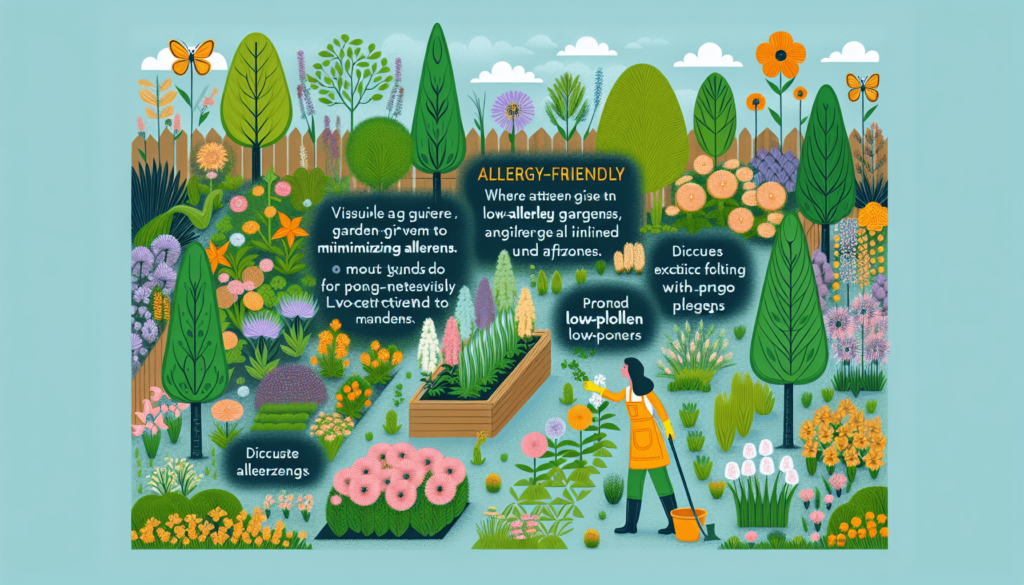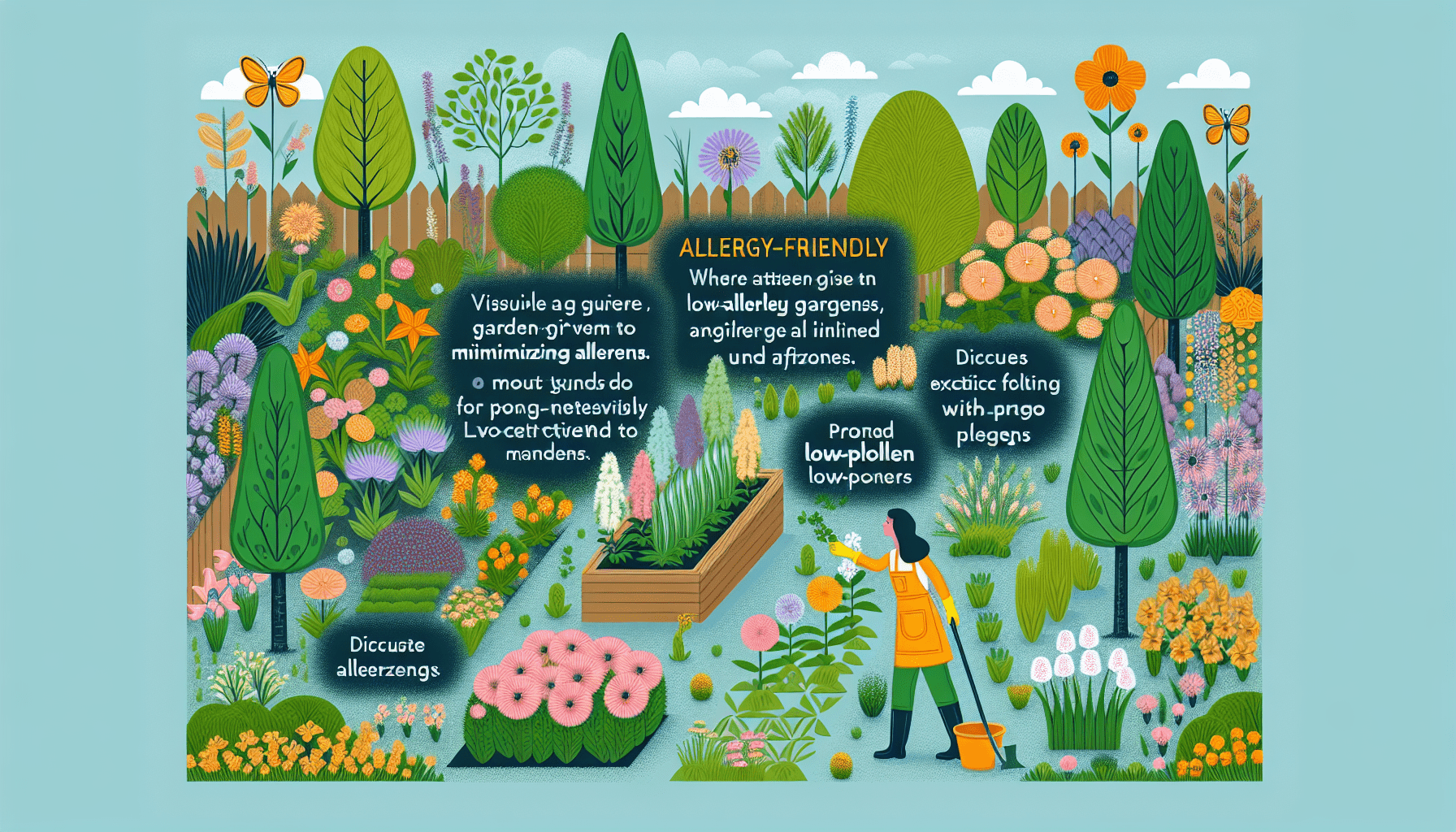If you or someone you love suffers from allergies, you know just how frustrating and uncomfortable they can be. Sneezing, itchy eyes, and a runny nose are all too familiar symptoms that can put a damper on your enjoyment of the outdoors. However, there is a solution that can allow you to continue enjoying nature without the constant discomfort: creating an allergy-friendly garden. In this article, we will share 10 tips on how to transform your garden into a haven free from common allergens, so you can breathe easy and fully embrace the beauty of nature right outside your door.

1. Choose low-allergen plants
Allergies can be a real nuisance, especially for those who love spending time in their gardens. However, by selecting low-allergen plants, you can significantly reduce the risk of triggering allergy symptoms while still enjoying the beauty and tranquility of your outdoor space. When choosing plants, it is important to do some research and opt for species that are less likely to cause allergies. By avoiding plants with high pollen counts, such as certain types of grasses and ragweed, you can minimize the amount of irritants in the air. Additionally, selecting plants with large, showy flowers can be a wise choice, as they tend to produce less pollen than plants with small, inconspicuous flowers.
2. Opt for native plants
Embracing native plants in your garden not only adds a touch of local charm but also helps create an allergy-friendly environment. Native plants are naturally adapted to the local ecosystem and climate, making them less likely to cause allergies. By planting species that are well-suited to your region, you are supporting local wildlife and biodiversity. Native plants provide food and shelter for native insects, birds, and pollinators which play a vital role in maintaining a healthy ecosystem. By choosing native plants, you are creating a harmonious balance in your garden and minimizing the risk of allergies.
3. Avoid high-allergen plants
To create a truly allergy-friendly garden, it is crucial to identify and avoid plants that commonly trigger allergies. Common culprits include certain types of trees, grasses, weeds, and flowers. Plants with small, inconspicuous flowers are often high in pollen and can exacerbate allergies. Take the time to research and identify plants that are known allergens and make a conscious effort to steer clear of them. If you already have high-allergen plants in your garden, consider removing them to further minimize the risk of allergies.
4. Create a barrier
Creating a physical barrier between your garden and neighboring gardens can significantly reduce the amount of pollen that enters your outdoor space. Planting hedges or utilizing fences can help block pollen from spreading. Additionally, considering installing a mesh or screen around your garden to further reduce pollen intrusion. These simple measures can make a big difference in minimizing exposure to allergens and creating a more allergy-friendly environment.
5. Maintain a clean garden space
Regular maintenance is key to keeping your garden free from allergens. Fallen leaves and debris can trap pollen and mold, so it’s important to regularly remove them. Mowing your lawn frequently can prevent grasses from producing excessive pollen. Keeping your garden free from weeds is also crucial, as some weeds are notorious for triggering allergies. By maintaining a clean garden space, you reduce the risk of allergens accumulating and ensure a more pleasant environment for allergy sufferers.
6. Install a water feature
A water feature such as a small pond or fountain can provide not only a visually appealing focal point but also help reduce pollen in the air. Water helps to keep pollen grounded and prevents it from becoming airborne, reducing the overall allergen count in your garden. Incorporating a water feature is a creative and effective way to create a more allergy-friendly space, while also adding a soothing element to your outdoor oasis.
7. Use non-allergenic mulch
Mulching is an essential practice in gardening, but it’s important to choose the right type of mulch to minimize allergy risk. Avoid using mulch made from materials that commonly cause allergies, such as cedar. Instead, opt for alternatives like shredded bark or compost. These non-allergenic mulches can still provide the necessary benefits for your plants, such as moisture retention and weed suppression, without triggering allergic reactions.
8. Plan your garden layout strategically
Strategic garden layout can go a long way in creating an allergy-friendly space. Positioning allergy-friendly plants downwind from seating areas helps minimize the likelihood of allergens reaching you while you spend time outdoors. By creating designated zones for different types of plants, you can minimize contact with allergens. This can be especially helpful if you have known allergies to specific plants. Consider grouping high-allergen plants together in one area, away from areas where you spend most of your time.
9. Consider companion planting
Companion planting is not only a clever gardening technique to optimize plant growth but can also help in repelling allergenic insects. Some flowers, herbs, or vegetables planted together can naturally deter pests that trigger allergies. For example, marigolds are known for repelling insects like mosquitoes and flies. Additionally, certain companion plants can help modify the soil to deter allergens. Examples include planting lavender alongside roses to repel aphids or interplanting legumes to fix nitrogen levels in the soil, reducing allergenic weed growth.
10. Minimize pesticide use
Chemical pesticides can exacerbate allergies by irritating the respiratory system. To create an allergy-friendly garden, it is advisable to minimize pesticide use and explore organic and natural pest control methods instead. Encourage beneficial insects and birds that feed on harmful pests by incorporating plants that attract them. This natural balance can help control pest populations in your garden without resorting to chemical intervention. By minimizing pesticide use, you create a healthier and more eco-friendly environment for both yourself and the local wildlife.
Creating an allergy-friendly garden may require some initial research and effort, but the benefits far outweigh the extra work. By incorporating these ten tips, you can create a beautiful and serene outdoor space that is less likely to trigger allergies. Remember to choose low-allergen plants, embrace native species, avoid high-allergen plants, and create physical barriers to reduce pollen intrusion. Regularly maintain your garden, consider installing a water feature, and use non-allergenic mulch to minimize allergens. Plan your garden layout strategically, explore companion planting, and minimize pesticide use to create a truly allergy-friendly environment. With these steps, you can enjoy spending time in your garden without worrying about pesky allergies ruining your outdoor experience.
